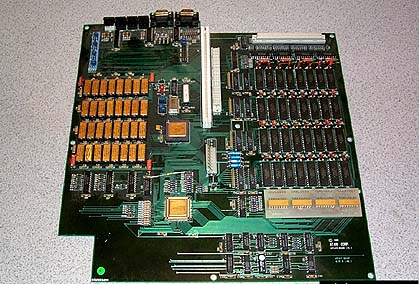Ram's Totally Unoffical ATW800 Homepage (original) (raw)
Welcome to Ram Meenakshisundaram's Transputer Home Page
"…sequential computers are approaching a fundamental physical
limit on their potential power. Such a limit is the speed of light…"

Ram's Totally Unofficial Atari Transputer Workstation 800 Pages*

These pages are dedicated to the Atari Computer Workstation (ATW800). I would like to see them develop into a resource for us poor beleaguered ATW800 owners scattered around the globe. If you have (realistic) ideas about what could be included here, please let me know via email.
The ATW800 was first introduced, under the name ABAQ, at the COMDEX show in Las Vegas in November 1987. Depending on which version of Atari's documentation you read, either 50 prototypes were released in May 1988, and 300 production machines in May 1989, or else there were 100 prototypes and 250 production machines. In either case it would appear that 350 machines were built in all. In 1995 ACN in the Netherlands held what appears to have been the final "closing-down sale", and of course Atari no longer exists as a company: so ATWs are now only obtainable second-hand.
The ATW800 was produced in collaboration with the U.K. company Perihelion a.k.a. Distributed Systems Limited; they appear to have been responsible for the hardware design (as evidenced by the copyright markings on the circuit boards), and their operating system "Helios" (a distributed un*x) was bundled with the ATW. Alas, Perihelion are no longer with us, but Olivier Aichelbaum has told me that in his final correspondence with them Perihelion granted permission for Helios to be distributed freely on a non-profit basis. I have therefore made a copy of Helios 1.3 available here. You should read the instructions in conjunction with my guide to getting started
The ATW800 comes in a rather imposing under-the-desk maxi-tower casing. The basic configuration consists of
- aforementioned case and power supply (how many Watts? Don't know, off-hand)
- the "I/O server", a modified MegaST board featuring the "Morpheus" SCSI interface;
- the main transputer motherboard, with a 20 MHz T800 and 4 MB of RAM;
- a video/X11 card, based around the "Blossom" chip, capable of
- 1280x960x16 colors out of 4096
- 1024x768x256 colors out of 16.7 million
- 640x480x256 colors out of 16.7 million, two screens
- 512x480x16.7 million
all at a refresh rate of 60 Hz non-interlaced
- expansion slots for
- up to four transputer farm cards, each holding either one T800 with 4 MB of RAM or four T800s with 1 MB each
- a crossbar switch to allow software-selectable configuration of the T800s
- a SCSI interface which can be directly accessed by a transputer, bypassing the MegaST "I/O server".
Thus a fully-equipped ATW800 could contain 13 transputers (260 megaflops) and 16 MB of RAM.
- External view
- ATW800 poses with its owner
- Diagram of front panel
- IO Subsystem
- Back of IO Subsystem
- Motherboard
- Blossom-based Video Card
There seem to be a lot of peoplestaring at an ATW they've just bought, with no documentation, saying to themselves "Great. No how do I start this thing?" If that's your situation, have a look at my guide to getting started. (Work in progress.)
If you have no copy of Helios, or if you want to try out version 1.3, here is a set of installation disks for Helios 1.3. And if you have no boot disk, or it seems to be corrupt, download thisSTZIPped archive of an ATW800 boot floppy.
I have some documentation on the Blossomchip, which may be of use to those trying to write device drivers: this is available in1st Word format. A C header file is also available.
The only other thing available so far isthe SCSI driver I inherited with my ATW. (This is the same one that's included on the boot disk above).
*The following pages are copied almost verbatim from the defunct Totally Unofficial ATW800 Page that was maintained by Chris Gray. I just reformatted it to be in-sync with the reset of my pages.